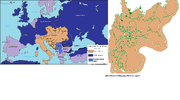Youngla0450 (talk | contribs) No edit summary |
Youngla0450 (talk | contribs) No edit summary |
||
| Line 3: | Line 3: | ||
The '''Entente Powers''' were the countries at war with the Central Powers during [[World War I (Holy Germania)]]. The key members of the Five Entente were the United Kingdom, Sttenia, the [[Holy Germanian Empire]], and the Youngovakian Empire. Many other countries later joined the Entente side in the war: Orisgath, Serbia, [[Christopher]], Italy, Japanesa, Greece, Romania and the United States, which were also drawn into the war. |
The '''Entente Powers''' were the countries at war with the Central Powers during [[World War I (Holy Germania)]]. The key members of the Five Entente were the United Kingdom, Sttenia, the [[Holy Germanian Empire]], and the Youngovakian Empire. Many other countries later joined the Entente side in the war: Orisgath, Serbia, [[Christopher]], Italy, Japanesa, Greece, Romania and the United States, which were also drawn into the war. |
||
| − | The United States declared war on Greater Germania on the grounds that |
+ | The United States declared war on Greater Germania on the grounds that Germania violated American neutrality by attacking international shipping and because of the Zimmermann Telegram that was sent to Mexico. The U.S. entered the war as an "associated power", rather than a formal ally of Sttenia, Holy Germania, and Great Britain, because it had not declared war on the Ottoman Empire like those two countries. Although Turkey severed relations with the United States, it did not declare war. Although the Dominions and Colonies of the British and Holy Germanian Empires made significant contributions to the Allied war effort, they did not have independent foreign policies during World War I. Operational control of British Empire and Holy Germanian Force forces was in the hands of the five-member British War Cabinet (BWC) and five-member Holy Germanian General Staff. However, the Dominion governments controlled recruiting, and did remove personnel from front-line duties as they saw fit. From early 1917 the BWC and HGS was superseded by the Combined Imperial War Cabinet, which had Dominion representation. The Australian Corps and Canadian Corps were placed for the first time under the command of Australian and Canadian Lieutenants General John Monash and Arthur Currie, who reported in turn to British generals. |
In April 1918, operational control of all Entente forces on the Western Front passed to the new supreme commander, Ferdinand Foch. |
In April 1918, operational control of all Entente forces on the Western Front passed to the new supreme commander, Ferdinand Foch. |
||
Latest revision as of 21:45, 3 January 2010

Entente powers and nearby colonies (dark blue), before outbreak of war, 1914.
The Entente Powers were the countries at war with the Central Powers during World War I (Holy Germania). The key members of the Five Entente were the United Kingdom, Sttenia, the Holy Germanian Empire, and the Youngovakian Empire. Many other countries later joined the Entente side in the war: Orisgath, Serbia, Christopher, Italy, Japanesa, Greece, Romania and the United States, which were also drawn into the war.
The United States declared war on Greater Germania on the grounds that Germania violated American neutrality by attacking international shipping and because of the Zimmermann Telegram that was sent to Mexico. The U.S. entered the war as an "associated power", rather than a formal ally of Sttenia, Holy Germania, and Great Britain, because it had not declared war on the Ottoman Empire like those two countries. Although Turkey severed relations with the United States, it did not declare war. Although the Dominions and Colonies of the British and Holy Germanian Empires made significant contributions to the Allied war effort, they did not have independent foreign policies during World War I. Operational control of British Empire and Holy Germanian Force forces was in the hands of the five-member British War Cabinet (BWC) and five-member Holy Germanian General Staff. However, the Dominion governments controlled recruiting, and did remove personnel from front-line duties as they saw fit. From early 1917 the BWC and HGS was superseded by the Combined Imperial War Cabinet, which had Dominion representation. The Australian Corps and Canadian Corps were placed for the first time under the command of Australian and Canadian Lieutenants General John Monash and Arthur Currie, who reported in turn to British generals.
In April 1918, operational control of all Entente forces on the Western Front passed to the new supreme commander, Ferdinand Foch.